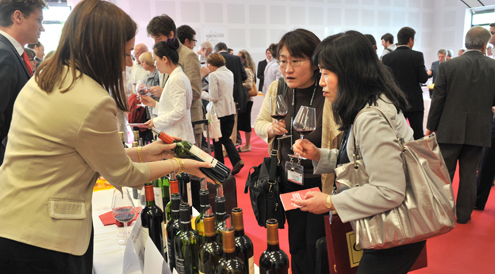The Evolving Chinese Wine Market
6 April 2012
저자: 지니 조 리

When New Food – the official media sponsor for the 86th China National Food, Wine & Spirits Fair – invited me to speak at its gala dinner in Chengdu earlier this month, I was immediately interested. Many China-based wine professionals had told me it was the largest and possibly the most important wine fair of its kind on the mainland. Since it is supported at the national level, the scale is huge and wine vies for attention among a host of local alcoholic beverages.
The magazine, one of the largest wine and drinks publications in China, devotes about a quarter of its coverage to wine; the rest mainly covers local spirits.
“It makes sense for us,” says Yang Zheng Jian, general manager for the publication’s wine business. “Seventy-five percent of our revenue is from local spirits so we need to devote more editorial coverage to it.”
Yang seems determined however, to shift that balance in favour of wine. When Yang joined the magazine in 2007, he says that Carruades de Lafite (the second wine of Chateau Lafite Rothschild) was selling wholesale for 600 to 700 yuan a bottle. His contacts in the wine industry all told him that Lafite and Carruades were selling like crazy and demand was exceeding supply. He wrote a story in October 2007 for predicting that Lafite was going to get very popular. Sure enough, over the next four years, Carruades shot up in price and, at its peak in China, it was trading for 4,000 yuan a bottle.
The Chengdu wine fair provides insight into the heart of China’s wine industry. Merchants from all over the country arrive not just to do business but to find out the latest trends and insights into the industry.
According to Yang, there are at least 30,000 wine merchants in China doing business on the retail, wholesale and distribution levels. People have swooped down on this industry with the belief that there is easy money to be made. The competition is fierce and many are struggling. Yang says: “Many importers are dying. They are discounting and selling without profit.”
Competition is growing and the scenery is changing quickly from the time when foreign-owned importers such as Montrose dominated the market. Home-grown companies such as C&D rank among the top ten importers now in volume and are poised to grow even faster than the likes of long-established Summergate or ASC.
These traders are gatekeepers, encouraging or discouraging specific styles and regions. At the moment, Lafite’s position as the darling of government officials and the opinion leaders in China seems to be waning. Yang says: “Lafite was important about five to eight years ago. Now people have moved on to Latour, Mouton, Margaux, Petrus, Le Pin and DRC [Domaine de la Romanee-Conti].” But DRC is the sole Burgundy on the hot list, are all from Bordeaux.
Yang says top Bordeaux chateaux are much easier to remember for mainland Chinese than Burgundy wines where the wine name consists of both the producer’s name, such as Domaine Meo-Camuzet, as well as the vineyard name (appellation) such as Chambolle Musigny. Yang adds: “The classification systems on the left and right bank [in St Emilion] in Bordeaux are obvious, stratified and clearly laid out.”
With gifting being such an important aspect of the wine business, there are two types of consumers: those who buy the wine, and those who actually consume it. Yang says: “Expensive wines above 1,000 yuan (HK$1,230) a bottle are often purchased by those who are giving it as a gift and the brands, wine names, must be recognizable.”
No one knows the exact percentage of wine destined for gifts, but all the merchants I spoke with believe that for fine wines, gifting purchases make up a greater proportion than those for drinking. It makes sense that Chinese consumers are chasing a limited number of brands – it is far better to give a gift to people that is recognised and appreciated rather than an obscure wine that the recipient does not know.
As long as gifting continues to be an important part of the wine business in China, the power of widely recognised labels such as Lafite will remain strong even as it makes room for other chateaux like Mouton or Margaux. While the growth of wine consumption in the coastal cities are slowing, the second- and third-tier cities are fast discovering wine. Importers talk excitedly about cities such as Ningbo and Kunshan.
It is a fascinating time to be following the wine industry in China – the picture changes every time I visit, which is nearly every other month.
Reprinted with permission from South China Morning Post









